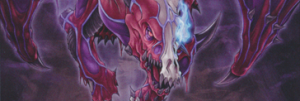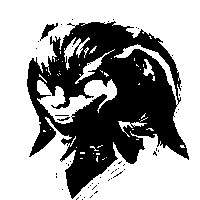The latest main booster set for the Yu-Gi-Oh! Trading Card Game, Power of the Elements, will release in just over a week. Expectations are high. Multiple powerful archetypes and generic cards debut in the set, which may well reshape the format – and just two weeks ahead of the prestigious European Championship.
Into this powder keg of anticipation dropped a bombshell: the signature Field Spell of the debut Tearlaments archetype, Primeval Planet Perlereino, had text that wasn't quite what players had assumed it would be.
If a "Tearlaments" monster (...) is shuffled into the Deck or Extra Deck (...)
In an archetype whose entire mechanic revolves around placing cards at the bottom of the Deck, this intuitively does not sound ideal compared to the fan localization of "returned to". The influencer tasked with revealing the text, having done due diligence, had preemptively noticed this quirk. When he asked KDE-US R&D for comment, they stated that the card still worked with the "Tearlaments" monsters' effect, despite appearances.
Now, I'm not a big proponent of overruling perfectly functional card text by mere fiat – after all, the entire purpose of Problem-Solving Card Text is to make cards function based on text alone. Also, historically, judges in KDE-E regions have not always considered themselves bound by US R&D's decisions. So, I decided to take a deep dive into the localization particularities surrounding Perlereino, to give some context to where we stand.

How to 戻す, and whether to シャッフル?
A brief historical tangent is necessary here. Once upon a time, cards were very wordy when shuffling cards into the Deck. Take, for example, the aptly-named Legacy Hunter – it specifies that the opponent returns a random card from their hand to their Deck, then shuffles the Deck. This somewhat clunky phrasing is an almost literal translation of the Japanese text for this effect. Here, the opponent is first instructed to modosu (return) a random card to the Deck, and then instructed to shaffuru (shuffle) their Deck.
Of course, in the modern game, card text space is at a premium – today's cards are simply no longer written that way. And, indeed, this will be where we encounter the two conflicting options that are ultimately at the heart of Perlereino's troubles. You see, when you're trying to cut that clunky text from earlier down to size, you can't avoid getting rid of one of the two instructions. Either you explicitly say to shuffle the card into the Deck, or you simply say to return it to the Deck, and leave the "shuffle" bit to be merely implied. Each option comes with its upsides and downsides – and the two CGs ended up on opposite ends of the coin.
In Japan, only very few cards will still explicitly tell you to shaffuru your Deck. In the entirety of 2021, only two OCG cards were (re-)printed with シャッフル as part of their effect text – Fukubiki, which kind of needs it, and Tuning, which has plenty of text box space. This is in contrast to 78 cards with the word "shuffle" in their English TCG text in the same year. These cards, in Japan, will only tell you to 戻す the card to the Deck.
This is not at all an unproblematic choice. If returning cards to the Main Deck implicitly requires you to shuffle, that's one extra thing for new players to get confused about. Especially for a card such as Pot of Duality, needing to shuffle is suddenly not obvious at all. It may have been this entirely valid concern that inspired the TCG to take the opposite route. A card such as Knightmare Unicorn, whose Japanese incarnation has it modosu a card, here shuffles that card into the Deck. This removes the ambiguity about what exactly to do with the returned card.

But what if you only return without shuffling?
Sadly, this localization choice is not without issue here, either. Since the Japanese text only specifies modosu (return), you're also only required to return the card to the Deck in order to have succeeded in that action in the OCG. For instance, the aforementioned Knightmare Unicorn merely requires you to succeed in returning the card to the Deck in order to be able to draw a card. Two documented scenarios illustrate this.
If you were to use Unicorn's effect to attempt to return a Monster Token, it will disappear upon leaving the field, and you will not be able to draw a card. However, if you instead attempt to return a Destrudo the Lost Dragon's Frisson that was Special Summoned using its effect to the Deck, and that Destrudo is placed at the bottom of the Deck as a result, you will still be able to draw a card. A number of rulings commentators have remarked on the strange nature of this apparent quirk in Unicorn's behavior, given its English text, over the years. Still, I am not aware of any serious attempts to diverge from this documented functionality in TCG events.
So, to summarize. The TCG will consistently localize unqualified modosu (return) as shuffle. This is a reasonable choice, which improves effect clarity in cases where you are instructed to modosu a card. TCG event precedent appears to overwhelmingly hold that this does not change functionality – shuffling a card this way is still considered to have succeeded as long as the card (no matter how) returned to the Deck.

Shuffling to the Primeval Planet – Perlereino
With all of the above in mind, it becomes fairly easy to see what went wrong in bringing Perlereino to the TCG. In its Japanese incarnation, its effect uses modosu – a card being returned to the Deck – in its activation condition. The TCG, appearing oblivious to context, chose to stick by its guns and localized this as shuffled. This isn't a new problem either – two Madolche cards (Salon and Chocolat-a-la-Mode) have done this exact thing in the past.
Now, it is easy to see how this differs from the Unicorn analysis in the previous section. There, you have an effect that tells you to modosu, to return, a card to the Deck. Changing this to tell you to shuffle the card is only clarifying how exactly this particular effect is performing its returning. In the case of Perlereino, a card being modosu-d, returned, to the Deck is the activation condition for its effect. Localizing this as shuffled is adding an extra requirement – it's limiting how some other effect must have done its returning in order to qualify.
Even worse, the "added clarity" argument of the Unicorn analysis disappears entirely. There is no ambiguity to an activation condition of "a card is returned to the Deck" to begin with. A card being shuffled into the Deck would, clearly, meet that criteria. Therefore, localizing modosu as shuffle, in the context of modosu having been done to a card, is solving a problem that doesn't even exist. Not only that, it's causing a lot of headaches while doing so.

Conclusion
I think Perlereino, just like Chocolat-a-la-Mode and Salon before it, is a product of a flawed localization process. Overly broad rules – modosu always being localized as shuffle – are followed without reflecting on their purpose. The result not only doesn't add clarity over the original, but even makes the intended functionality be at odds with an intuitive reading of its text. In a game which aims for its cards' text to be self-contained, that is an issue.
So, what should happen now?
I would call upon Konami to issue a Database erratum for Perlereino at the earliest available opportunity, preferably immediately upon release. Recent experience with Aluber shows that this is very possible to do. Even if the erratum may not have been strictly necessary in their view, it will still establish unequivocal clarity going into a very important event. While they're at it, they should also fix the two Madolche cards' texts to match.
Additionally, Konami should adjust their localization guidelines for modosu to only apply to the imperative. "You should modosu a card" being localized as "you should shuffle" is fine, but "a card has been modosued" being localized as "a card has been shuffled" is not. This is important future-proofing, especially in case Japan ever decides to create an effect that actually asks for a card to have been shaffurued.
As for us Judges – well, I hope we get that erratum. In case we don't, I'd view Perlereino's use of shuffled as a localization-induced systemic quirk, not a true difference in text functionality. I'd compare it to how the TCG uses Tribute Summon to include Tribute Set. I'd let it activate. I think that's the more sensible way to go on this one.
Or, at least, that's my opinion.
Power of the Elements releases in Europe on Thursday, August 4th.




